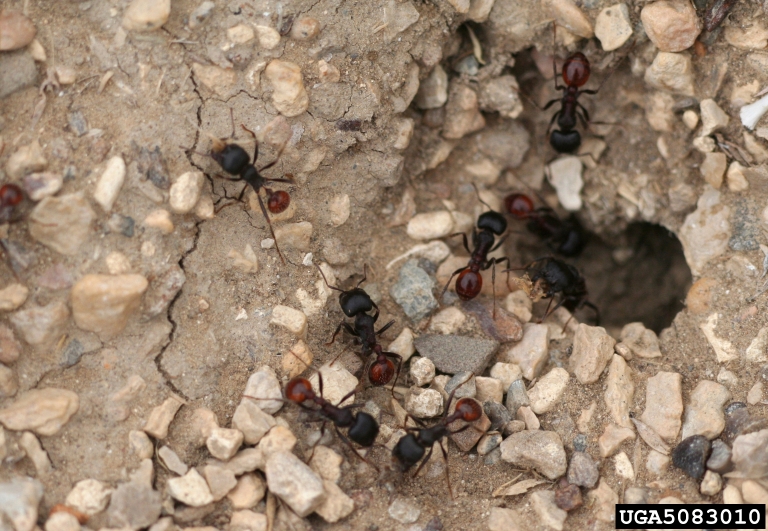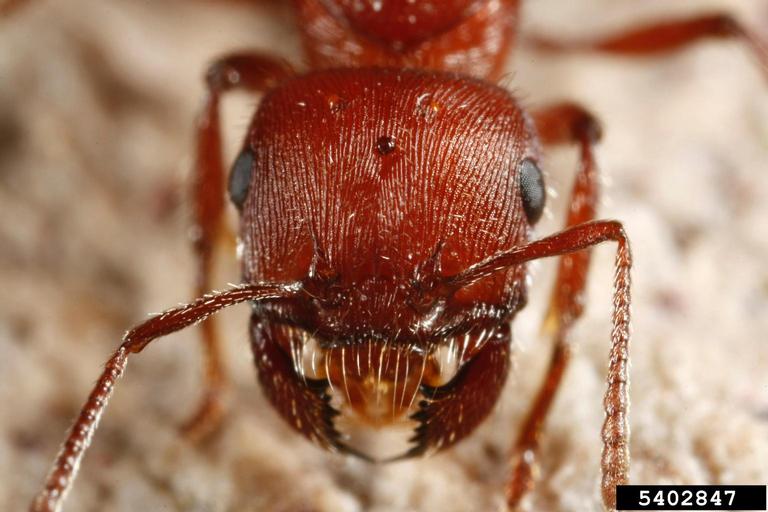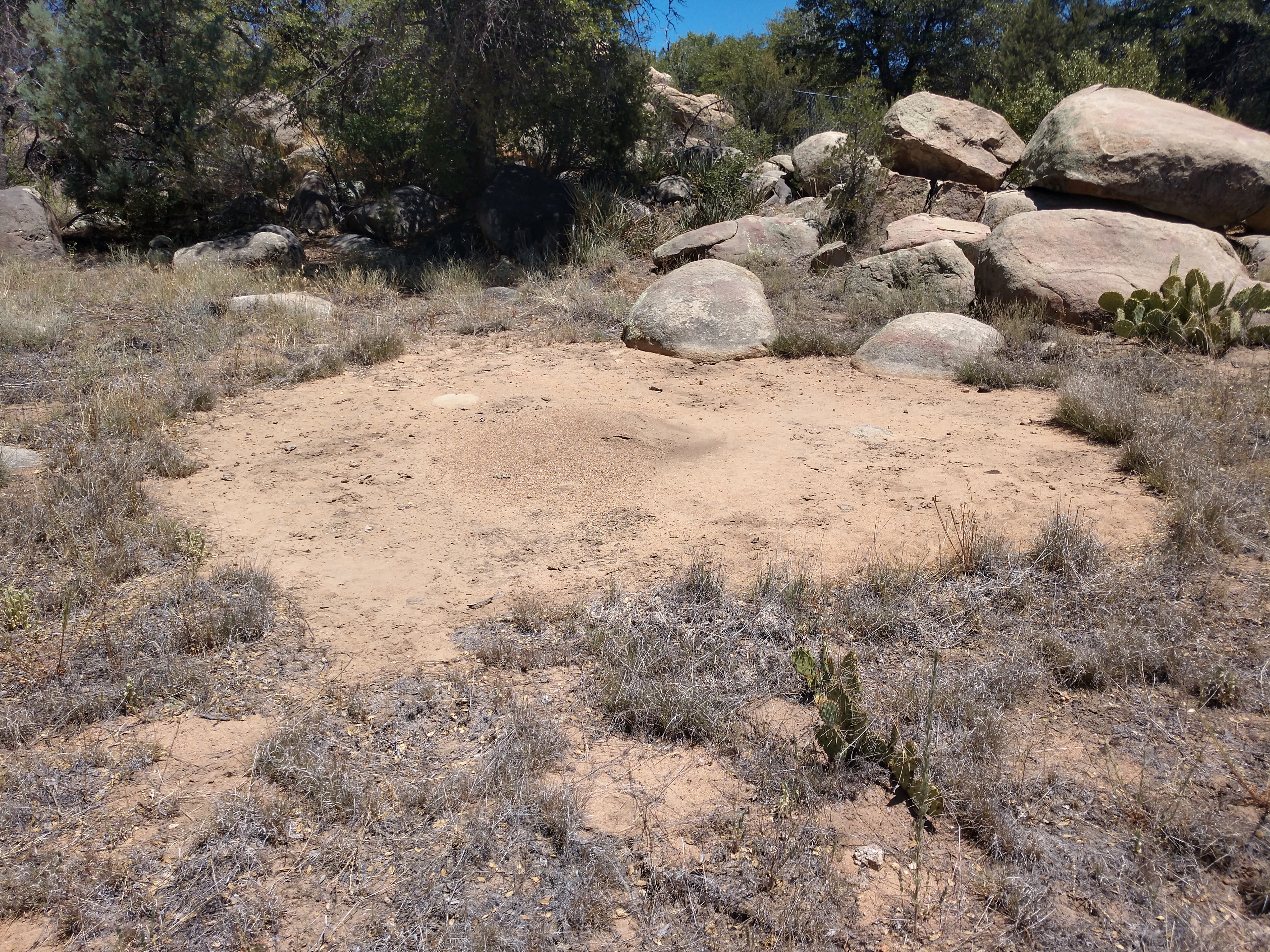 Harvester Ants - July 17, 2019 Jeff Schalau, Agent, Agriculture & Natural Resources University of Arizona Cooperative Extension, Yavapai County Harvester ants (Pogonomyrmex spp.) are most noticeable in wildland areas by the 4 to 35-foot-wide circular bare spots they create on the soil surface. In open spaces p.away from people and pets, they are a beneficial member of their ecosystem and should be left alone. Harvester ants disperse seed, increase permeability of soils, and feed other organisms. Horned lizards (horned toads) rely on harvester ants for food which compose up to 90% of their diets. When harvester ants are found in your yard, it is up to you to decide whether or not they pose a risk. You should consider letting them be if they are in a quiet corner of your property. There are 22 species of harvester ants found in the United States (several of these are found in Arizona). Harvester ant workers are usually between ¼ and ½ inch in length and colors range from orange, to red, brown, or black. They can sting and will aggressively defend the nest if threatened. People having allergic reactions to insect stings should be especially careful. Some species of harvester ants have stingers with reverse barbs which pull out when used, much like honey bees. In Arizona, winged male and female harvester ants swarm, mate and establish new nest areas in spring or summer, usually following a rainy period. The males mate with the queen and die. After finding a suitable nest site, the queen drops her wings, digs a burrow and produces a few eggs. Larvae hatch from eggs, go through several stages (instars), and pupate before becoming adults. Workers produced begin caring for other developing ants, enlarge the nest, and forage for food. Harvester ant queens are long-lived and continue laying eggs to build and maintain the colony. Harvester ant workers keep the nest area devoid of vegetation to regulate underground temperature. Mounds composed of fine gravel are often built in the center of the cleared nest area (depending on harvester ant species). There may also be small bits of charcoal and fragments of dead vegetation. The nests are commonly three feet deep and have one to three entrances. At Hanford Nuclear Reservation (in Washington state), harvester ants were thought to have exhumed buried radioactive waste from a depth of 15 feet. Harvester ants exhibit two foraging patterns. Some species leave the nest individually and disperse in all directions. Other species use scent-marked “trunk routes” and disperse at a further distance from the nest. Harvester ants forage primarily for seeds but sometimes feed on insects. They typically gather only one seed species until it is gone then shift to another species. The seeds and insects are stored in the nest as food for the colony. I have also watched harvester ants carry bits of chicken feed distances over 100 feet across our yard to their nest. Harvester ants have chewing mouthparts to grind food items into ingestible pieces. Workers may also feed the colony by laying unfertilized eggs to be fed to the queen and larvae. Research projects on some species have demonstrated that harvester ants can change plant species composition around their nests and can create islands of increased nutrient availability to plants in the vicinity. I have included several images of harvester ants and a nest below. As stated above, only nests posing a threat to people or pets should be treated. Only apply pesticides after you have evaluated the situation and determine treatment is necessary. Unwanted harvester ant nests can be treated with pesticide baits labeled for that purpose. The most common active ingredient is hydramethylnon. These baits are available at most hardware stores and garden centers and are suitable for landscapes, driveways and non-cropped areas. Since harvester ants are least active during the hottest part of the day, this is an ideal time to apply pesticides. As with any pesticide, ALWAYS FOLLOW LABEL DIRECTIONS. Licensed professional pesticide applicators may also be employed and have access to other suitable products. Finally, I encourage you to observe harvester ants from a distance and appreciate their role in your local food web. You can follow the Backyard Gardener on Twitter – use the link on the BYG website. If you have other gardening questions, call or email the Master Gardener help line in the Prescott (928-445-6590/prescottmg@gmail.com) or Camp Verde (928-554-8992/verdevalleymg@gmail.com) and be sure to include your name, address and phone number. Find past Backyard Gardener columns or provide feedback at the Backyard Gardener web site: http://cals.arizona.edu/yavapai/anr/hort/byg/. Photos  Rough harvester ant (Pogonomyrmex rugosus) workers (from: Whitney Cranshaw, Colorado State University, Bugwood.org).  Close-up of harvester ant head showing mandibles (from: Joseph Berger, Bugwood.org).  Harvester ant nest in Prescott, Arizona (Jeff Schalau). Additional Resources Red Harvester Ants, Utah State University Extension utahpests.usu.edu/ipm/ornamental-pest-guide/arthropods/ants/harvester-ants Harvester Ants, Texas A & M AgriLife Extension counties.agrilife.org/galveston/files/2012/03/Red-Harvester-Ants-Publ.-E-4021.pdf |